Mother of thousands plants are succulents, which means they tend towards a low-maintenance existence. This means they are excellent plants for folks who are busy, not that great with keeping a plant watering schedule, or just starting out as houseplant keepers.
The mother of thousands is a plant in the Kalanchoe genus and it is often mistaken for other plants in the same genus. If you see lists of “varieties” of mother of thousands, you’re looking at lists of other plants in the Kalanchoe genus, not actually other varieties of mother of thousands. Many are very similar, however, such as mother of millions or the chandelier plant. If you’re not well-versed in the plants, you likely may not even be able to tell them apart visually.
The mother of thousands has the botanical name of Kalanchoe daigremontiania though it was formerly known as the Bryophyllum daigremontianum. Either name refers to the same plant, if they are referenced properly.
Other common names for the mother of thousands plant is the Mexican hat plant (not to be confused with the prairie coneflower which has the same nickname), alligator plant, or devil’s backbone. The plant grows natively in Madagascar but has easily been naturalized in many other regions of the world. However, if they are grown outside, they may easily become invasive, since they are self-propagating plants that spread their plantlets extremely easily.
It should be noted that the mother of thousands plant contains a toxic element and therefore should be kept out of the reach of children and pets.
To learn about the meaning of the mother of thousands plant, please read our article on the topic. And if you’d like to consider hanging a mother of thousands plant, you’ll find a guide with ideas and tips in this article.
Mother of Thousands Size
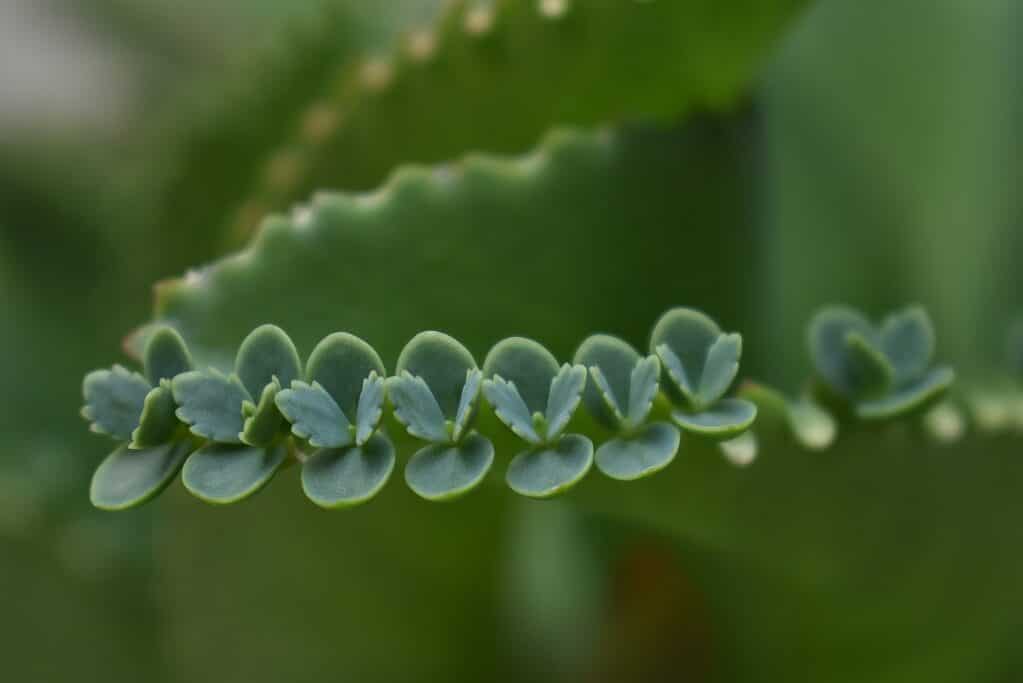
Tiny plantlets grow along the edge of the mother of thousands plant leaves.
©
Before we dive into the care guide, it’s important to note that mother of thousands is typically sold as a smaller plant but they may grow up to three feet in height. They are fairly slow-growing plants, despite multiplying quickly, however, and likely will be well suited to a single pot for quite some time before they need to be repotted.
Mother of Thousands Care: Soil Needs
Mother of thousands is a succulent plant that natively grows in sandier soils. However, the key to their growing medium is not the content as much as it is proper drainage. The plant cannot handle too much water, so it’s imperative that you plant the mother of thousands in a pot that has loose soil (ideally sandy soil) with proper drainage holes at the bottom. It’s recommended that you add some gravel at the bottom of the pot, as well, to help ensure drainage occurs.
You may enhance the soil with vermiculite, as well, to help keep the soil light and airy, and draining well. Add some pumice throughout the potting mix to create gaps, and add perlite, as well.
You can use potting mixes for cactus or succulents or create your own. Be sure the mix does not contain peat moss or loam, however.
Mother of Thousands Care: Watering
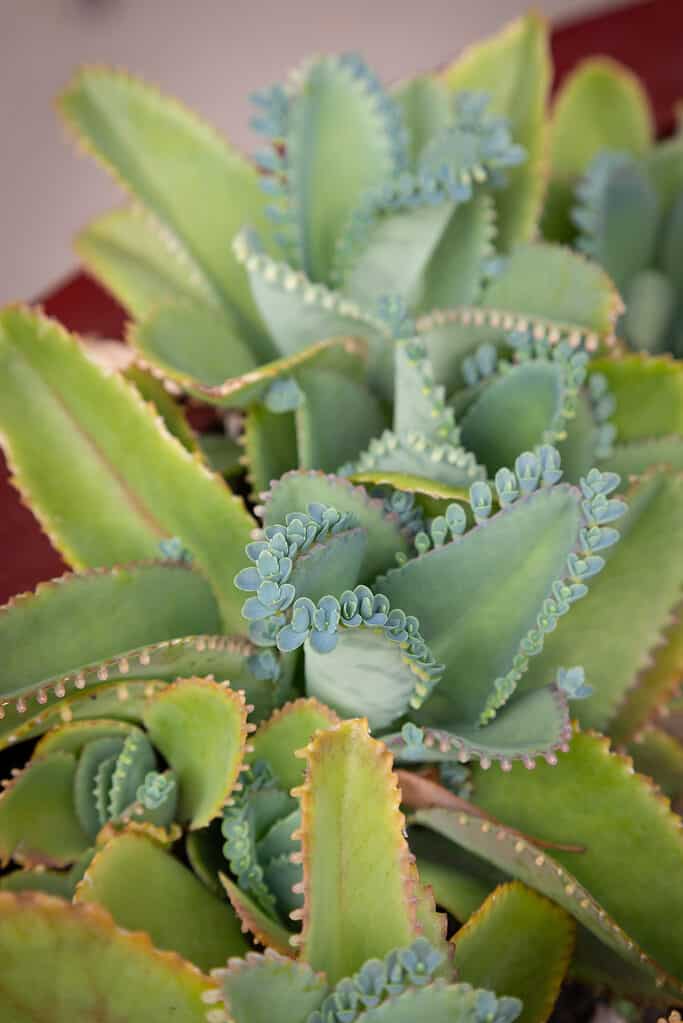
Mother of thousands plants should be cool green with a blue-gray hue or bright green.
©iStock.com/Athichai Chaweesook
As a succulent, mother of thousands plants don’t need a lot of water. In fact, if they receive too much water, they will become ill and even die.
Test the soil to check for moisture or use a moisture meter. If the soil is at all damp, skip watering that day. Wait for the soil to dry out (though not so much that the plant withers!), usually at least one week between waterings. The plant often only needs watered every two weeks or so.
If you have trouble remembering to water the plant this infrequently, you may wish to use a calendar app or alarm to remind you to check the soil five or six days.
Mother of thousands should be watered with pure water, ideally rainwater, or distilled water, that is room temperature only. Never use cold or hot water, as these may damage the plant.
Tip: If the leaves start to droop, wilt, or change colors, the plant is most likely being overwatered. Scale back and let the soil dry out and reschedule the watering frequency dramatically.
Mother of Thousands Care: Light Needs
While they are light lovers, mother of thousands plant care involves placing these succulents in indirect, bright light. They actually don’t do well in hours of direct exposure to sunlight, so they should not be kept on windowsills that receive a lot of warm light. Instead, provide them with indirect light via closed windows with sheer curtains, shade cloth outdoors, or placement near windows without the direct, intense light beating down on them.
Easterly-facing windows are best, with westerly or southerly-facing windows acceptable. Never place them in northerly-facing windows, particularly in the summertime.
And avoid placing them somewhere that they’ll have to be moved from frequently, as this can stress the plant. Instead, find the location where indirect light is receivable for the majority of the year.
If you don’t have the appropriate windows, there are some LED lights you can use that can provide light at the proper brightness without the harshness of the sun. This is also necessary for the plants on overcast days, particularly on back-to-back days of darkness.
Best Temperature for Mother of Thousands
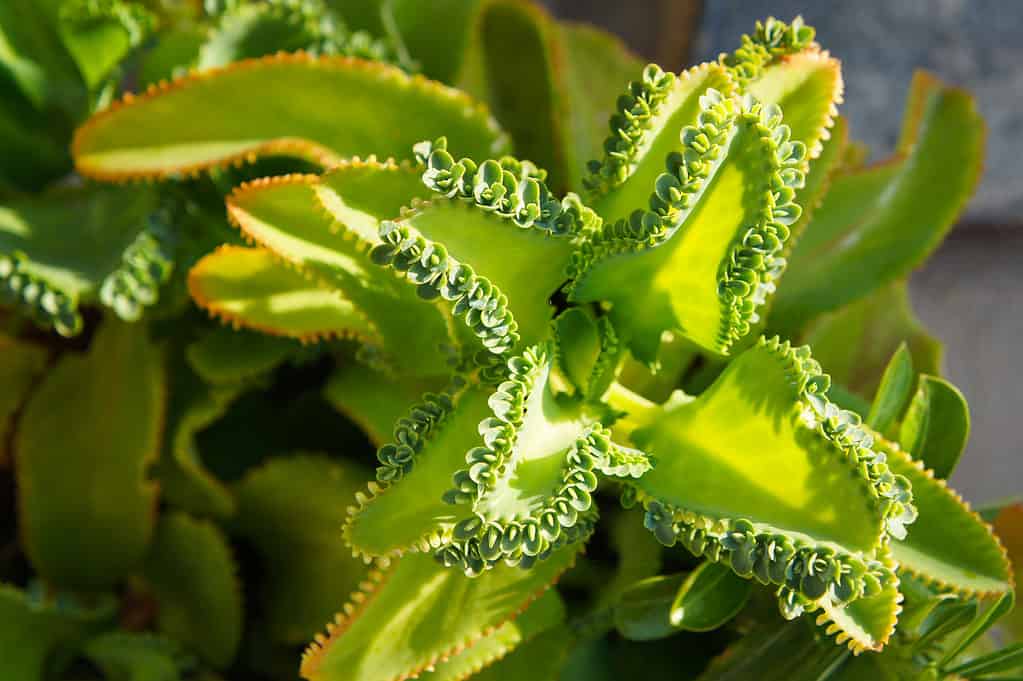
Never place a mother of thousands plant in a northerly-facing window, particularly in the summer.
©iStock.com/skymoon13
Mother of thousands prefer temperatures between 65- and 75 degrees F. This makes them ideal for indoor spaces, since most of us keep our homes at around this temperature. If the plant is kept outdoors, make sure it is brought inside before temperatures hit 40 degrees F.
Best Container Types for Mother of Thousand Plants
Often, we think of the right pot for plants as an aesthetic choice. However, for certain plants, there are some specific qualities that can improve their health.
For mother of thousands plant care, your best bet is going to be a clay or terracotta-type pot. This material absorbs excess water – the big killer of most house-bound succulents! – and help drain the plant’s soil properly.
Make sure the pot is unglazed. Avoid plastic liners and ensure the planter has proper drainage holes.
Mother of Thousands Care: Fertilization
The growing season for mother of thousands plants is in the spring and summertime, into early autumn at the latest. Once about every three months, it’s a good idea to fertilize your mother of thousands during the growing season, though if you’re off a little, it won’t matter too much. The plant doesn’t require much.
Water the plant before you fertilize it, then use a balanced fertilizer either intended specifically for succulents or with an NPK ratio of 15-15-15 or 10-10-10. This is an equal ratio of phosphorous to nitrogen to potassium.
In most cases, the fertilizer will need to be diluted a bit. Check the package instructions to verify the correct ratio of fertilizer to water.
If after you fertilize the plant you notice any of the following signs, discontinue fertilization for several months and look for a gentler fertilizer after.
- Withering leaves
- Streakiness (yellow, brown, or white)
- Discoloration of leaves to yellow or brown
If you do notice any of these signs, immediately remove the plant from its pot and remove as much of the soil as you can. Replace the soil with new, fresh soil, and skip fertilizing. Water instead and let the plant rest.
Re-potting Mother of Thousands Plants
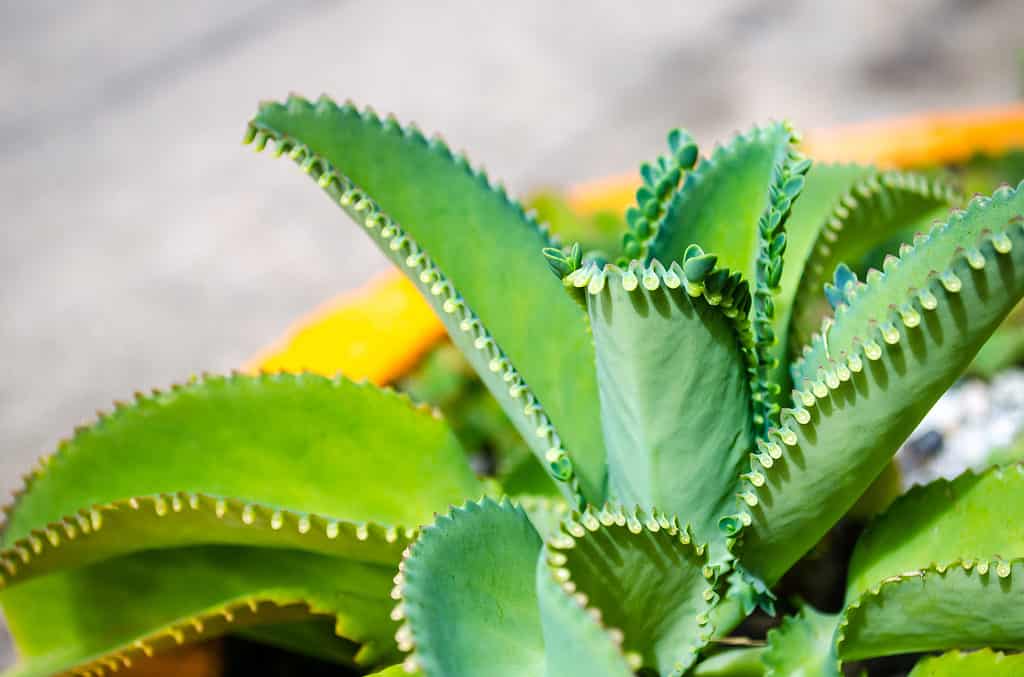
The plant is vibrant and unique looking – and makes for a great gift!
©iStock.com/Norrabhudit
Like many succulents, mother of thousands don’t require re-potting terribly often. The plant is a slow-grower, so it’s usually only every couple of years that it needs a larger pot.
When you notice the roots starting to grow through the drainage holes at the bottom of the pot, you know it’s time! If the soil is drying out faster than it used to or if the leaves and stem seem stunted in growth – these are also signs it’s time to re-pot.
Wait until spring to re-pot the plant. Then find a pot that’s the “next size up” from the current size for the re-pot, or, perhaps, two sizes up, depending on your preferences. The plant will do fine in either. Ensure this new pot has proper drainage and plant per usual, with the correct potting mix, some pebbles or pumice to help drain the soil, and, of course, fully functioning drainage holes.
Refill the new pot with one-third of the potting mix or soil, then tamp it down to settle it a bit. Spread your fingers out and place your hand around the mother of thousands plant’s stem. Gently turn the pot upside down and gently squeeze the pot to loosen the plant and soil.
Look over the roots and trim any that are broken or dead, mushy looking or rotten. You can also trim back any roots that are a bit longer than the others, to help ensure they fit into the new pot properly.
Gently place the plant into the new pot, with the roots about 1 inch below the pot’s top edge. Add in soil and tamp down to compact it somewhat, but don’t overfill the pot. There needs to be some space to allow the plant’s roots to breathe properly.
Using room temperature water, add some moisture to the soil. Let the soil absorb it, then water again once or twice to ensure the new soil is evenly moist and ready to grow the plant. Once water drains from the drainage holes, the plant is all set and ready to be placed in its permanent growing location.
Propagation of Mother of Thousands Plants
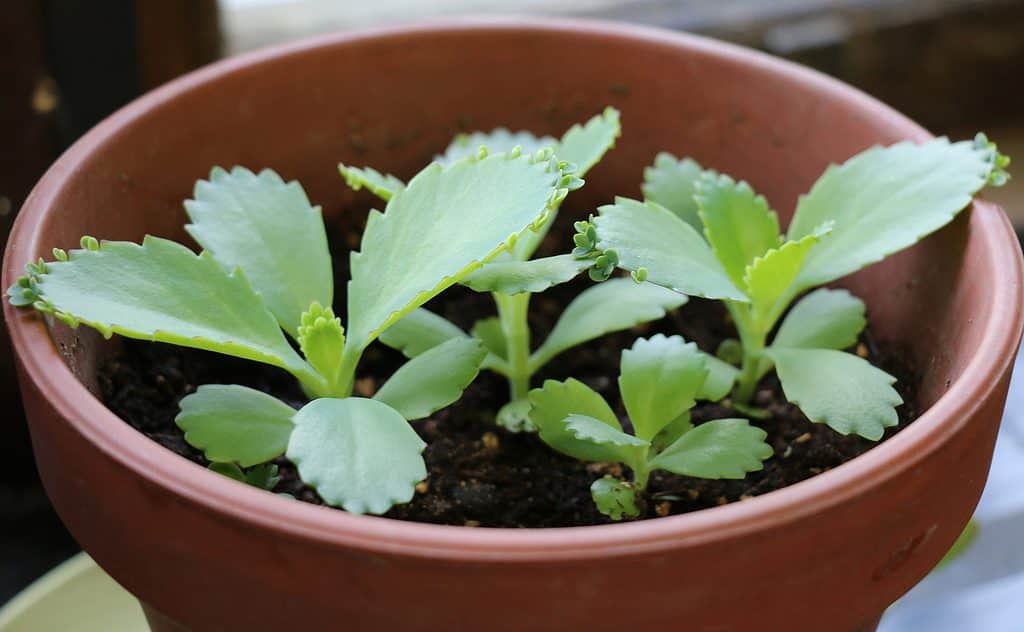
Young mother of thousands plants already show off their own tiny plantlets.
©lqlqlqlq75 / Pixabay – License
One of the things that makes mother of thousands plants so unique is that they are self-propagating. Those little plantlets that grow at the edges of their leaves are how they perpetuate their species. And, to propagate your own, all you need is some of those plantlets. In fact, you can’t grow these from seeds – they don’t create them.
When the plant goes dormant in winter, the plantlets drop off the leaves. If you prefer, you can gently brush the edges of the leaves to encourage the plantlets to drop. Avoid putting too much pressure on this, though, as you could damage the plant. If they don’t come off, give it a few days and try again.
To plant the plantlets, fill a pot with some potting mixture and moisten the soil. Place the plantlets onto the soil. Cover the pot with cling wrap or a thin plastic sheet to help keep in moisture.
As the plantlets sit in the soil, keep them moist by misting the soil with water. Once the plants form roots, they’re ready to re-pot and grow on their own.
Common Problems
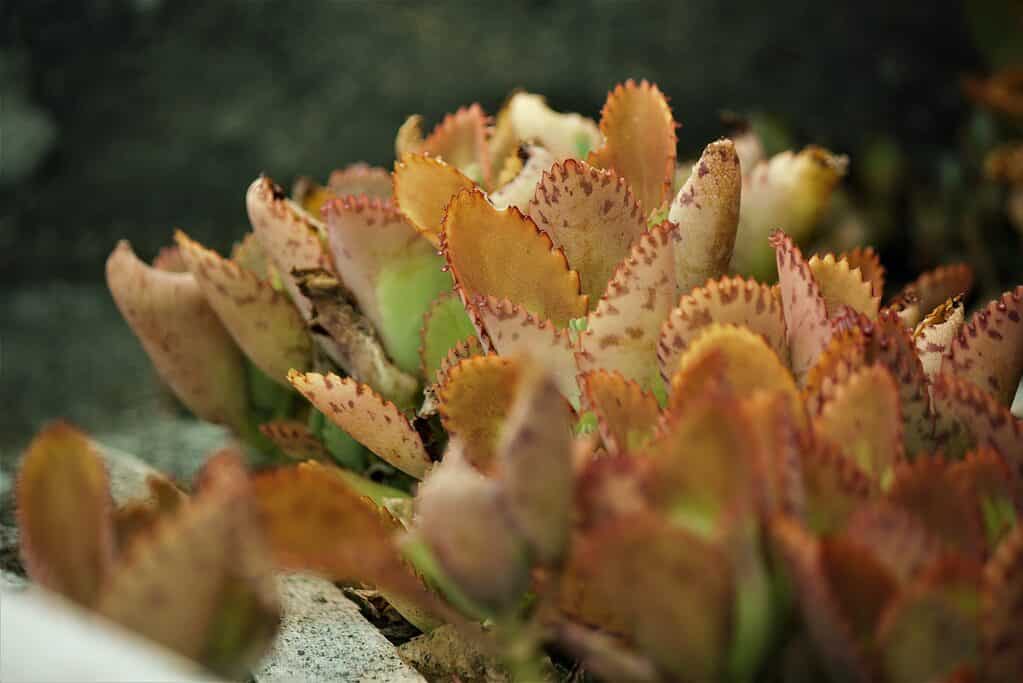
Discoloration is usually a sign of something wrong with mother of thousands care.
©
There are a few common problems that mother of thousands plant care faces. Primarily, this is overwatering, which results in root rot, and a few insects and pests that may infest occasionally.
Root Rot
If you over-water your mother of thousands plant, you’ll likely notice some discoloration of leaves, wilting, or similar issues. You may also notice that the plant could turn black and look dead. The reason for all of this is the same: over-watering, resulting in root rot.
If the plant has turned black all over, you may not be able to save the plant, but if it’s black or discolored in part, you may be able to save it by removing the plant from its pot, removing the old, soaked soil, and replanting with fresh new soil. If you see any rotten, dead, or over-saturated roots, trim these off gently, ensuring you leave healthy roots on the plant. Slightly moisten the soil by misting it after repotting and then let the plant dry out for the next few weeks. Check the soil often, though, to ensure it’s not too dry.
If you do wind up dealing with root rot and over-watering, it’s highly recommended you acquire a moisture meter to avoid the issue in the future.
Mealy Bugs and Aphids
Some of the most common pests that mother of thousands deal with are meal bugs and aphids. Mealy bugs are small, wingless, dull-white insects that leave behind a waxy, powdery covering. Aphids are small dots that appear on the plant, often on the underside of the leaves. Both insects suck the life out of plants by literally draining them of their fluids and contained nutrients.
To get rid of these pests, isolate the infected plants and apply a gentle, nontoxic pesticide. Ideally, use neem oil or another natural solution.
Note: Never apply pesticides when the soil is wet. Wait for the soil to dry before applying to avoid harming the plant.
Leaf Spots
Another common issue is that of leaf spots, which are caused by bacteria or fungi. These appear as brown of black splotches on the leaves, either in ragged or circular shapes, with a wet-looking yellow edge to them. These are caused by dirty tools, rain, insects, or other contact with similarly infested items.
If these appear on your mother of thousands, remove the infected leaves when the plant is dry. Dispose of any leaves that have fallen and then apply a gentle fungicide as directed on the label.
Pruning Mother of Thousands Plants
Occasionally, your mother of thousands plant care may involve pruning. If the plant starts to look wiry, you’ll want to put on some gloves and pinch off the top of the plant, immediately above a large leaf. This helps to promote growth in the plant.
Caution: If your skin comes into contact with the plant, be sure to wash it immediately with soap and water and avoid touching your face.
The photo featured at the top of this post is © lqlqlqlq75 / Pixabay – License / Original
Thank you for reading! Have some feedback for us? Contact the AZ Animals editorial team.






